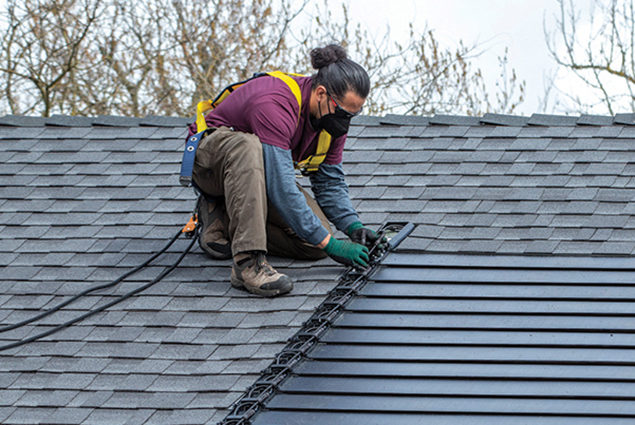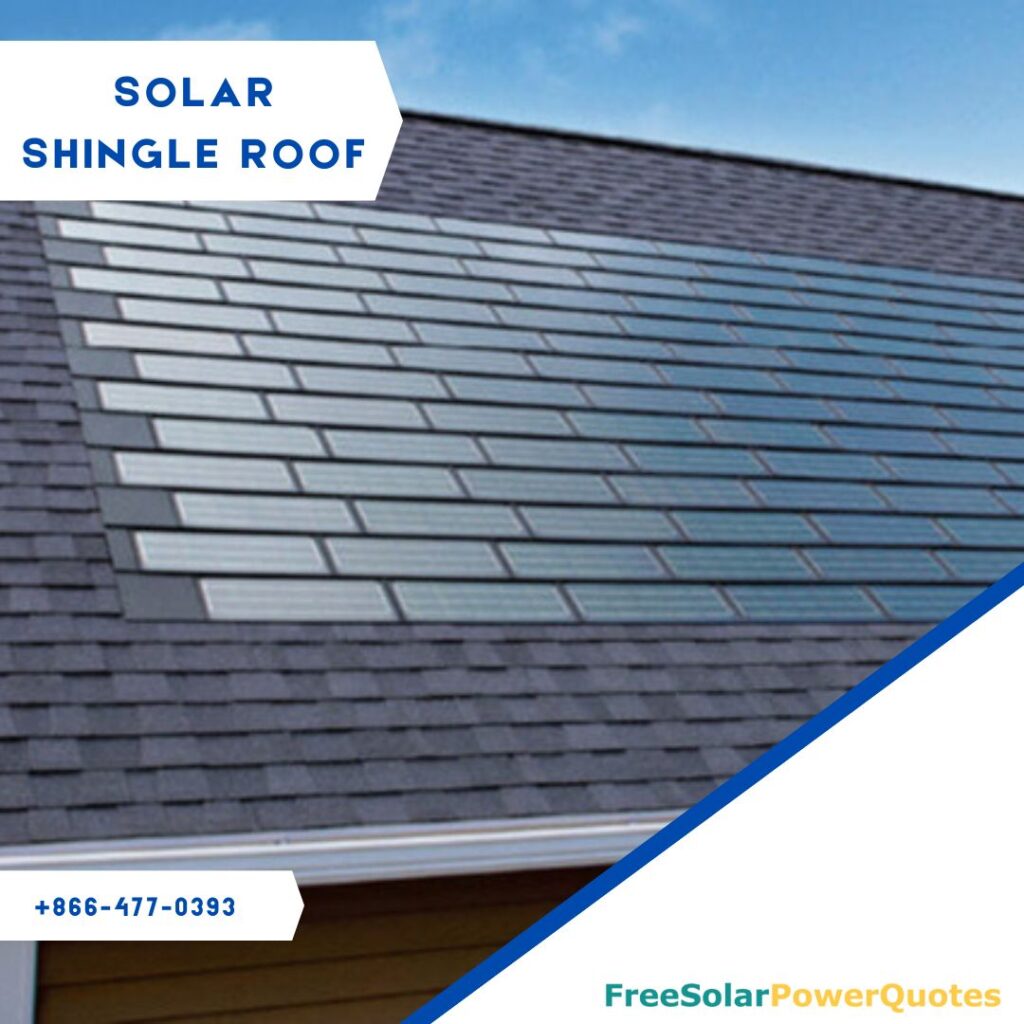Due to technological advancements, people’s preferences change over time. Most people are now inclined towards renewable energy resources, particularly solar energy, for generating electricity. Using solar-powered electricity is not only good for the environment, but it also impacts your savings. While solar panels are a popular choice, solar shingle roof are another option for homeowners who want to add value to their properties and homes.
What is solar shingle roofs?
Solar shingles, also known as solar roof tiles, are thin PV (photovoltaic) sheets that add to or replace the existing roof shingles. They absorb the sunlight energy and convert it into electrical energy. If homeowners use solar energy instead of grid utilities, they will save more money on monthly bills and eventually reimburse their initial investments.
Like regular shingles, solar roof shingles keep your home safe from the weather and other environmental conditions. These shingles are energy-efficient and provide a more appealing aesthetic to your home than the large, bulky panels typically associated with photovoltaic energy.

The difference between solar shingle roofs and solar roof panels
Solar shingle roof works similarly to solar roof panels—they both use sunlight energy and convert it into electrical energy. Nonetheless, there are a few key differences to consider when determining your home’s solar energy requirements:
Size
Solar shingles are roughly the same size as traditional roofing shingles, with dimensions 12 inches × 86 inches on average and weighing about 13 pounds per square foot. These photovoltaic titles are less than one inch thick, and it takes approximately 350 tiles to build a typical solar roof.
Materials
Solar roof shingles are made from four different chemicals which are indium, copper, gallium, and selenide. The physical properties of these elements make these titles more thin and flexible. This semiconductor is an excellent material for making shingles because it has a high conversion efficiency rate of 10 to 12 percent on average. Some manufacturers even use monocrystalline silicon to fabricate shingles—the same material used to make computer chips. Although these titles are more expensive, they are worthwhile as they have 15 to 20 percent higher production rates.
Power output
A solar power system typically has a higher production capacity and can help you save a large amount of money on your utility bills. The majority of shingles range in power output from 13 to 63-watts. The number of solar tiles in a typical home roof installation can reduce utility bills by 40 to 70 percent, and by adding more titles (shingles), you can increase the power output.
As mentioned earlier, solar panels and solar shingles work similarly and convert sunlight energy into electricity. Let us look at some of the factors that will help you decide between two options.
Appearance
Many people prefer solar shingles to large black panels attached to the roof because they blend in with the roofing materials, such as asphalt or concrete. Solar shingles typically have a sleeker appearance than bulky solar panels, and only a portion of the roof covered in shingles is as efficient as the large solar panel.
Service Life
Solar shingles and panels both have long lifespans, typically exceeding 20 years. Nevertheless, the longevity of solar shingles varies depending on the brand, quality, and installation. Warranties also vary, so read them carefully before purchasing solar roof shingles. Solar shingle warranties may last for several decades, depending on the manufacturer, whereas durability warranties that include the shingles themselves may last for the entire life of the home.
Efficiency
One of the significant advantages of solar panels is that you can change the direction of the panels to achieve the best angle for harnessing solar energy. On the other hand, solar roof shingles remain in the same place where they were initially installed. You can add more solar shingles to your roof, but as with any home renovation project, more tiles mean more money.
Installation Process
Solar shingles installation can take up to one week only if your home is in good condition. But if you are building or redoing your roof before adding a solar shingle, it may take even longer. Some solar tile manufacturers, such as Tesla, will require two or more weeks for system installation.
As opposed to solar shingles, you can install solar panels on your roof in one day.
Durability
Durability or resilience is one of the main factors that separate solar shingles from solar panels. Unlike solar panels, solar roof tiles are more durable and built into the roof itself. Therefore, they are more resilient and can withstand harsh climate conditions and fallen objects. Furthermore, solar shingles are more fire-resistant than solar panels. (It’s important to note that the risk for fire with photovoltaic cells is relatively low.)
Price
Solar roof tiles typically cost more than photovoltaic cells because of the number of materials required for installation. The average cost of solar shingles ranges between $15,000 and $20,000, but Tesla shingles may cost over $70,000, plus a lengthy installation period. However, the final cost of solar shingles depends on your family’s energy needs, the size of the roof, and the provider and installer of the shingles you have selected.
The benefits and drawbacks of solar roof shingles
Here’s a brief explanation of the benefits and drawbacks of solar roof tiles for your home:
Pros:
- Shingles have a sleeker, more enticing aesthetic. They work particularly well with asphalt and concrete roofs.
- Shingles are weather-resistant and long-lasting.
- They require little maintenance as compared to solar panels.
- They’re a worthwhile option if you’re building a new roof.
Cons:
- Solar panel systems have been around for a long time, but solar shingles are relatively new. Therefore, most solar providers do not offer them.
- Technology is evolving at a rapid pace. Not all existing roofs are suitable for solar shingle installation; you may need to rebuild the rooftop to adjust these titles.
- They are currently limited in designs, style, and color, but brands like Tesla & Dow are introducing new options.
Where to buy solar roof shingles
There are only a few brands manufacturing solar roof shingles on a large scale. You should request free quotes from the brands of your choice and evaluate their prices and unique selling propositions to determine which ones best meet your budgetary constraints.
Best five brands for solar roof shingles
1) Tesla (the main leading brand)
There is only one option if you are looking for the best solar shingles for your home: Tesla. Tesla solar shingles were introduced in 2016 following the company’s trillion-dollar acquisition of “Solar City”. Furthermore, Tesla shingles are made of quartz, which enhances their efficiency and durability. Tesla not only manufactures the shingles, but it also manages the entire process, from design to installation, including the removal of the old roof, if applicable. These shingles are available in various textures and come with a 30-year power warranty. Furthermore, they also introduced a system-maintenance app that can help you check the energy levels of your solar shingles at a glance.
2) CertainTeed
CertainTeed solar roof shingles are made with the same monocrystalline material used for solar panels. There are two styles available: one for concrete tile roofs and another for asphalt roofs.
3) SunTegra
SunTegra is another option for homeowners looking for a more affordable solar roofing option. Its simple, lightweight design reduces installation time and blends well with concrete or asphalt roofs.
4) Luma
Luma solar roof shingles stand out from the competition due to their high efficiency (21 percent) and durability. They are pressure-resistant and can withstand high wind pressure equivalent to Category 5 hurricanes. This is the only brand that provides new designs as technology advances, which is a great feature to get the latest solar roof shingles.
Key Takeaway!
The popularity of solar power industries has increased significantly, which is why building-integrated photovoltaics (BIPV) products are in high demand. Furthermore, all solar products available on the market are energy-efficient and eco-friendly. Nevertheless, not everyone will be persuaded to buy when they do not have enough space in their home. Thus, the solar industry must find a way to integrate all of these solar technologies into residential areas while remaining unobtrusive.
Fortunately, the industry has developed a new concept of solar roof shingles. The primary purpose of creating solar shingles (solar tiles) is to combine two essential functions- to act as a solar panel and the roof simultaneously- into one solar product. Solar roof shingle is an innovative BIPV product and is an excellent option for individuals who want to acquire a residential solar power system.
Solar roof shingle is a new solar product, and only a few companies are actively selling it. Tesla is one of the leading solar power companies that manufacture high-quality solar roof shingles. Some companies have begun to develop their brand for solar shingles, while others are in the planning stages.
Switching to a solar power system is simple, and the advantages of going solar are best visible in the long term. Visit our site, FreeSolarPowerQuotes, and get a free quote now.

